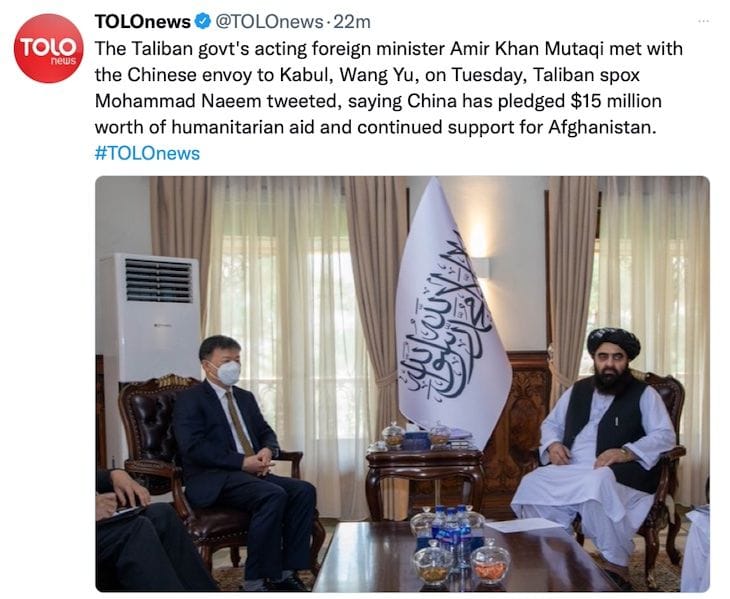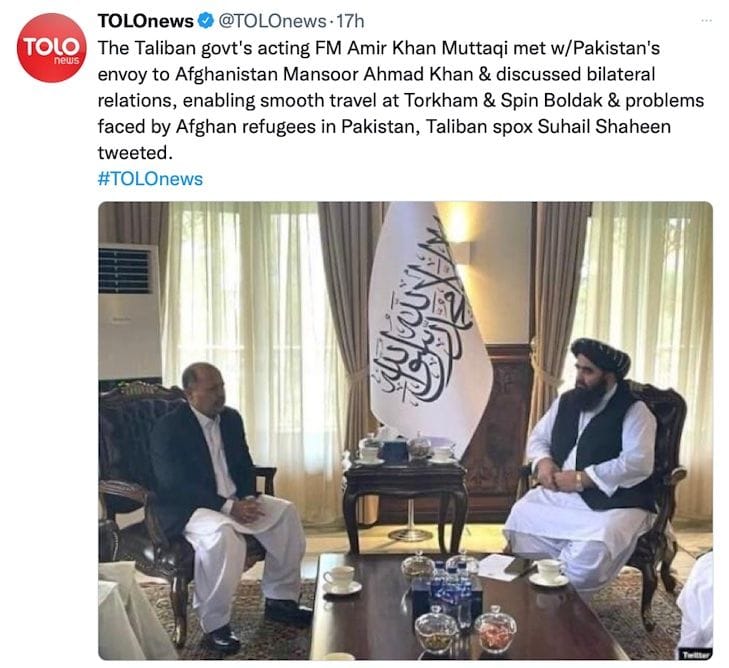After nearly 20 years the United States and NATO withdrew their troops from Afghanistan at the end of August, abandoning their Afghan allies at the mercy of the Taliban, who after a lightning-fast series of advances throughout the country, paraded in US-made Humvees to celebrate their victory.
The US did not only leave thousands of high-end weapons, aircraft, equipment and armored vehicles for the Taliban to seize. It left behind a massive humanitarian disaster including 14 million people without food, 2 million malnourished children, more than 3.5 million internally displaced people and a gender apartheid.
The botched Western withdrawal (and betrayal) also left behind a vacuum of foreign influence waiting to be filled. Afghanistan is positioned at the junction of several nuclear powers aiming to be regional leaders and preying on the country – among those, China.
China – already the largest foreign investor in the country – has signed Afghanistan’s first major oil exploration contract back in 2011; it has provided over 13,000 tons of food aid in recent years; it has pledged to spend 3 billion dollars to develop the Aynak copper mine and much more.
Afghanistan is certainly not a terra incognita for China but after being accused for years of “free-riding” and making investment deals while US and NATO forces paid “in blood and ammo”, Beijing now has a larger gap to fill.
China’s strategy in Afghanistan is based on two pillars: stability and Afghan-owned, Afghan-led solutions, which on the ground translate into deals and negotiations with the Taliban, rather than fights and wars against them. China does not worry about partner countries’ regimes or forms of government, and it does not (pretend to) care about human rights violations.
As Chinese Foreign Minister Wang Yi said during talks with the delegation led by Taliban co-founder Mullah Abdul Ghani Baradar: “The Taliban in Afghanistan is a pivotal military and political force, and it is likely to play an important role in the process of reconciliation and reconstruction in Afghanistan… After all, 20 years, trillions of dollars, and a huge military could not eliminate the Taliban”.
Urban middle classes, minorities, and women who now are being pushed to accept the reality of living under the Taliban are paying the heavy price of America’s untrustworthiness, the international community’s apathy, and China’s realpolitik.
China has made clear that it looks forward to having friendly relations with the Taliban and has announced USD 31 million in aid. But to understand to what extent China wants to get involved in Afghanistan, it is important to assess the interests, the potential risks, and the larger Chinese policies in the region.

Interests and rewards
China values stability in Afghanistan and on its borders specifically. The Taliban present the possibility of restraining the security threat posed by the East Turkestan Islamic Movement (ETIM) to China because of the Taliban’s links and connections with the group. Wang has made the remark during the meeting with the Taliban’s political chief and urged them to crack down on the group. China does not want Afghanistan to become a safe haven for South-Central Asian militants, who could shake its stability in its Western provinces.
Additionally, Afghanistan has the potential of being integrated into the Belt & Road Initiative. It can be a vital connectivity hub, as it offers China the shortest way to the Middle East and ultimately Africa.
Moreover, a successful Chinese policy in Afghanistan could also revive the Amu Darya energy projects and other investments projects that have been in stasis for many years. Beijing can also benefit from the huge mineral wealth of Afghanistan.
More importantly, Afghanistan provides a chance for China to reshape its global image as a responsible international actor capable of working on security architecture and imposing its hegemony in a region where Western powers have failed. Beijing can also use the Taliban’s victory to mock the West’s “defeat” and democracy in general. Hu Xijin, who heads the Chinese Communist Party's Global Times, tweeted: “Chinese netizens joked that the power transition in Afghanistan is even more smooth than presidential transition in the US.”
Risks and threats
In Afghanistan China faces a huge degree of uncertainty. Most Chinese investments were stalled in the past years because of insecurity. With the US withdrawal and Taliban takeover, the security situation is even more uncertain. There are many sources of violence and resistance: militias, private military contractors, inter and intra-tribe conflicts are an important part of the equation. Many scholars argue that policymakers are oblivious to the fact that Afghanistan is home to not one but five distinct conflicts. They also doubt that Beijing will launch ‘mega investments’ before there is stability. Consequently, Afghanistan may become a testing ground for Chinese peacebuilding capacities.
However, it is still uncertain to what extent China has a say on Afghan affairs. The situation in Afghanistan can be unpredictable and China may have to get its hands dirtier than it usually prefers, something it tries to avoid as much as possible.
Despite China’s ability to reach out to major Islamic factions all over the world while simultaneously persecuting Uighurs, it is still unsure if the Taliban will accept China’s request to curb the activities of the ETIM. Within the Taliban movement, some may perceive such a collaboration as a betrayal of fellow Islamists, and this might negatively affect the group’s cohesion. The Taliban may not be ready to distance themselves from transnational jihadists and economic aid may not be a sufficient incentive for the Taliban to keep its promises.
The regional dimension
Afghanistan retains a pivotal role between India and Pakistan, China, Iran, and former Soviet Republics. The regional dimension of the crisis is based on shared concerns and interests.
The post-American Afghanistan allows for more cooperation opportunities between Russia and China. The Sino-Russian camp is gaining valuable strategic advantage in the heartland vis-a-vis Western powers, which have been focusing on the rimlands. In a conversation with Russian Foreign Minister Sergey Lavrov, Chinese Foreign Minister Wang Yi stated the need for a solid and mutually beneficial partnership: “Under the new situation, it is necessary for China and Russia to strengthen strategic communication and collaboration. First, China and Russia should protect each other’s legitimate interests in Afghanistan…”
Pakistan, often referred to as the Taliban’s chief host and backer, remains an important actor. Recently, China has unveiled a five-point plan agreed with Pakistan to align the two countries’ strategies for Afghanistan. Beijing seeks to link the China-Pakistan economic corridor (CPEC) with the Trans-Afghanistan railroad and Belt & Road projects.

For India, the Taliban takeover will push it to recalculate its strategic options. Indian investments and projects like Salma Dam and Zaranj-Delaram highway are now under Taliban control. The Taliban takeover may also hinder the Indian-aided venture of Shahid Beheshti oceanic seaport in Chabahar, Iran, as a competitor to Gwadar port, 175 kilometers to the west in Pakistan. India invested 100 million USD in the development of the port, as a counter to the China-Pakistan partnership at Gwadar.
At the same time, Iran has welcomed Taliban rule in Afghanistan. However, Iran can expand its influence in the country through proxies as it does in Iraq, Lebanon, and elsewhere. The Fatemiyoun Brigade, a militia composed of Afghan fighters who were recruited, trained, and equipped by the Qods Force for fighting in Syria beginning in 2012, can be used to set up a Shia safe haven in Herat province.
Finally, Turkey does not want to be left out of the political space that is opening up and it is rapidly adapting to the new reality in Afghanistan. They are negotiating with the Taliban to operate the Kabul international airport along with Qatar, through private firms.
To sum up, Afghanistan is a hotbed for geopolitical ambitions, cooperation, competition, and conflict. China may have significant plans for this troubled country, but it still has not placed all its cards on the table. Since the Chinese leadership is aware of Afghanistan’s geographical and historical specificities and it carefully monitors the neighbors’ ambitions, Chinese actors will inject financial resources into the country, under the pretext of rebuilding it and extending the Belt & Road Initiative. Investing in a Taliban-controlled country will not only legitimize and empower the group but it can drown the country in Chinese loans and give Beijing the upper hand.
Time will tell how the China-Taliban relationship will develop and what it will create for the future of Afghanistan. Nonetheless, it is a paradoxical friendship: China has banned burqas, veils and “abnormal” beards in its biggest Muslim city, while Taliban forces men to grow a beard and women to fully cover themselves. Power and money triumph over ideology.
Cover photo: High level meeting in Tijanjin between the PRC's Minister of Foreign Affairs and Taliban's political office delegation, 28 July 2021. Source: China's foreign ministry via Twitter.
